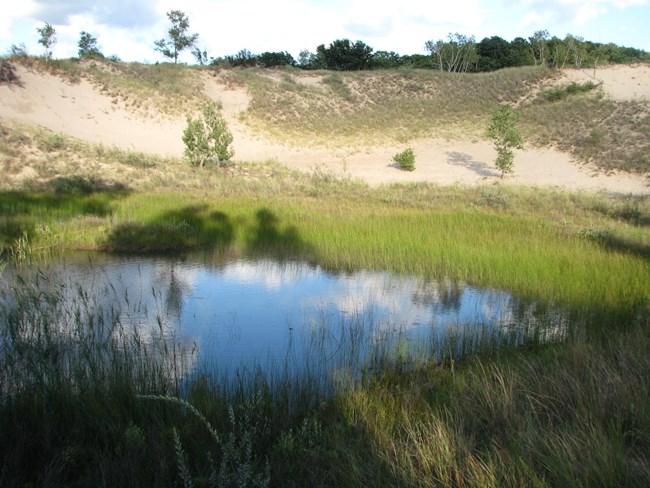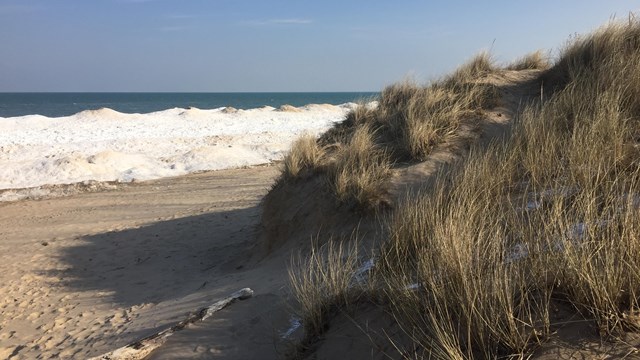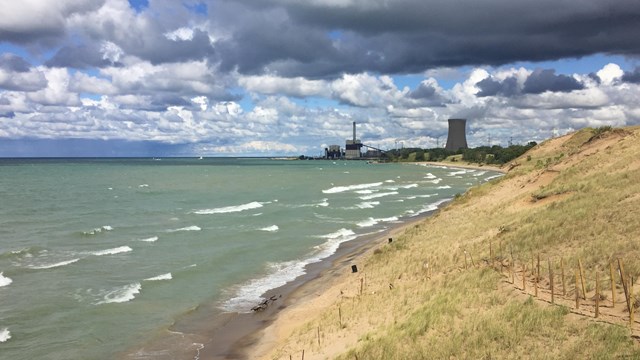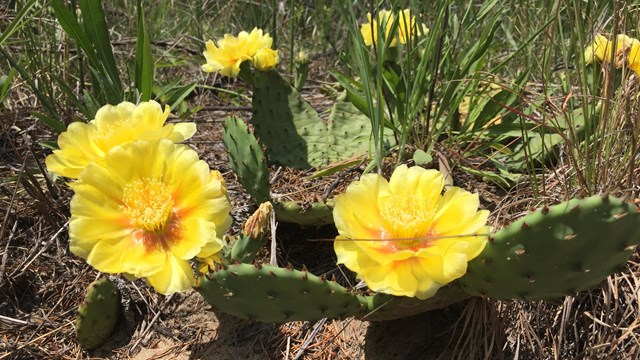"I believe climate change is fundamentally the greatest threat to the integrity of our national parks that we have ever experienced. The current science confirms the planet is warming and the effects are here and now." - Jonathan Jarvis, National Park Service Director, 2009
NPS Collection The successional habitats that exist in the parks depend on natural disturbance processes (e.g., wind, shoreline erosion, fire, etc.) to sustain their rich plant communities and the range of animals they support. As human development fragmented the landscape and suppressed wildfires, oak habitats have flourished and invaded other habitats, bringing with it a decrease in plant species. In some areas, dunes and wetlands have been damaged by human traffic or changes in hydrology. Restoration and conservation activities have reversed some of the harm, but the delicate habitats that have endured despite their human neighbors for over a century are now being stressed by climate change. Recent studies from the National Park Service Climate Response Program found that temperature, precipitation, and indications of the onset of spring relative to historic values (1901- 2012) are already exposing the Indiana Dunes region to climate impacts. One-fifth of the length of the park’s lakeshore is highly vulnerable to lake level changes. Rising temperatures are expected to make habitats less hospitable to some species, especially boreal plants, and forest compositions will change as habitats for many tree species are driven northward. Like most of the Midwest US, precipitation in Indiana Dunes is expected to become characterized by fewer but heavier rain events, with an overall decrease in precipitation during the summer and an increase during the winter months. Winter precipitation will shift away from snow, falling in the form of rain more and more, and Lake Michigan may eventually have less ice cover. The number of days within the growing season has increased and is expected to continue doing so by as much as a month’s time by the middle of the century, with the expectation of earlier springs and later autumns. Land managers at state and national parks are being encouraged to “manage for change”, especially as climate forces impose an increasing amount of stress on these natural areas. The US National Park System (NPS) has developed a Natural Resource Adaptation Strategy aimed at making the parks more resilient to climate change through enhancing specific elements. The elements include availability of climate refugia (habitats that persist as climate changes), landscape corridors that allow plants and animals to move to more suitable locations, healthy populations with sufficient genetic diversity to adapt, blocks of natural landscape large enough to be resilient to large-scale disturbances and long-term changes, and fewer additional threats and stressors. Adaptation options assembled in this plan range from resisting impacts to embracing an evolution in habitats that results in a suite of ecosystem functions that are better suited to future conditions. Land managers will benefit from carefully assessing goals in conjunction with environmental monitoring and climate forecasts to prioritize actions. Shifts in growing seasons will necessitate changing the timing of some activities, such as prescribed fire. In addition, managers may need to adapt the nature of the burn (intensity and duration) to hotter and drier conditions, and adjust fire management protocols to create refugia, new habitats, and to preserve vulnerable species (e.g., boreal, etc.). v Coordinating with regional planners will enable managers to enhance corridors in the fragmented landscape that will allow plants and animals to migrate. Infrastructure at the parks will need to be improved, and this is an opportunity to re-evaluate park structures and roads that are better suited to future conditions. The parks will benefit from adding to their monitoring activities to create a “watch list” of southern invasive species that will be moving into the area, and connecting with other land managers to share information about best management practices for controlling their current invasive species. Finally, park managers may want to consider creating messaging systems that advise area residents, staff, and visitors about climate related threats such as extreme heat, flooding, an increase in the number of ticks, more wildlife encounters, etc. Building resiliency in natural habitats under a rapidly shifting climate requires thoughtful but deliberate actions. The depth of commitment, knowledge, and cooperation among the many experts in the region is an asset that can be leveraged through continued communication and coordinated planning. To that end, this adaptation plan will benefit from regular evaluation and updates in order to assess new impacts and vulnerabilities and to fine-tune adaptation strategies that are specific to the Indiana Dunes region. The above excerpt is from the Indiana Dunes Climate Change Adaptation Plan. Finalized in May of 2018, the plan lists anticipated changes to the dunes and includes strategies for adapting to those changes.

Climate Change Curriculum
Middle school lesson plans highlighting local climate change and its effects. 
Additional Resources
Useful links to expand climate change understanding. 
Climate Change and Your National Parks
The National Park Service is responsible for many of our nation's most treasured places. Learn about how climate change threatens them.
Visit our keyboard shortcuts docs for details
In the spring of 2016, the Climate Change Response Program partnered with No Barriers Youth to provide the inaugural Every Kid in a Park: Climate Change Bootcamp. Held at Indiana Dunes National Lakeshore, this novel program brought 17 high school students from Chicago to the lakeshore for three days and two nights to learn about the impacts climate change is causing and the steps the NPS is taking to respond. On the third day, the high school students invited a local 4th grade class to be taught by their newly minted high school student teachers. Follow along for this wonderful new program, and see some of the new and novel ways we communicate climate change with our nation’s students. |
Last updated: July 26, 2023
